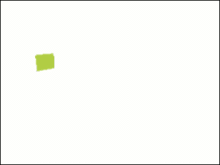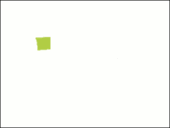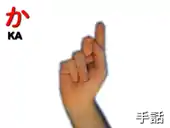| ka | |||
|---|---|---|---|
| |||
| transliteration | ka | ||
| translit. with dakuten | ga | ||
| translit. with handakuten | (nga) | ||
| hiragana origin | 加 | ||
| katakana origin | 加 | ||
| Man'yōgana | 可 何 加 架 香 蚊 迦 | ||
| Voiced Man'yōgana | 我 何 賀 | ||
| spelling kana | 為替のカ (Kawase no "ka") | ||
| kana gojūon | ||||||||||||||||||||||||||||||||||||||||||||||||||||||||||||
|---|---|---|---|---|---|---|---|---|---|---|---|---|---|---|---|---|---|---|---|---|---|---|---|---|---|---|---|---|---|---|---|---|---|---|---|---|---|---|---|---|---|---|---|---|---|---|---|---|---|---|---|---|---|---|---|---|---|---|---|---|
|
||||||||||||||||||||||||||||||||||||||||||||||||||||||||||||
| Kana modifiers and marks | ||||||||||||||||||||||||||||||||||||||||||||||||||||||||||||
| Multi-syllabic kana | ||||||||||||||||||||||||||||||||||||||||||||||||||||||||||||
Ka (hiragana: か, katakana: カ) is one of the Japanese kana, which each represent one mora. Both represent [ka]. The shapes of these kana both originate from 加.
The character can be combined with a dakuten, to form が in hiragana, ガ in katakana and ga in Hepburn romanization. The phonetic value of the modified character is [ɡa] in initial positions and varying between [ŋa] and [ɣa] in the middle of words.
A handakuten (゜) does not occur with ka in normal Japanese text, but it may be used by linguists to indicate a nasal pronunciation [ŋa].
か is the most commonly used interrogatory particle. It is also sometimes used to delimit choices.
が is a Japanese case marker, as well as a conjunctive particle. It is used to denote the focus of attention in a sentence, especially to the grammatical subject.
| Form | Rōmaji | Hiragana | Katakana |
|---|---|---|---|
| Normal k- (か行 ka-gyō) |
ka | か | カ |
| kaa kā |
かあ, かぁ かー |
カア, カァ カー | |
| Addition of dakuten g- (が行 ga-gyō) |
ga | が | ガ |
| gaa gā |
があ, がぁ がー |
ガア, ガァ ガー |
Stroke order
 Stroke order in writing か |
 Stroke order in writing カ |
The Hiragana か is made with three strokes:
- A horizontal line which turns and ends in a hook facing left.
- A curved vertical line that cuts through the first line.
- A small curved line on the right.

The Katakana カ is made with two strokes:
- A horizontal line which turns and ends in a hook facing left.
- A curved vertical line that cuts through the first line.
Other communicative representations
| Japanese radiotelephony alphabet | Wabun code |
| 為替のカ Kawase no "Ka" |
ⓘ |
 |
|
 |
 |
| Japanese Navy Signal Flag | Japanese semaphore | Japanese manual syllabary (fingerspelling) | Braille dots-16 Japanese Braille |
Braille representation
| か / カ in Japanese Braille | Other kana based on Braille か | ||||||
|---|---|---|---|---|---|---|---|
| か / カ ka | が / ガ ga | かあ / カー kā | があ / ガー gā | きゃ / キャ kya | ぎゃ / ギャ gya | きゃあ / キャー kyā | ぎゃあ / ギャー gyā |
Computer encodings
| Preview | か | カ | カ | ゕ | ヵ | |||||
|---|---|---|---|---|---|---|---|---|---|---|
| Unicode name | HIRAGANA LETTER KA | KATAKANA LETTER KA | HALFWIDTH KATAKANA LETTER KA | HIRAGANA LETTER SMALL KA | KATAKANA LETTER SMALL KA | |||||
| Encodings | decimal | hex | dec | hex | dec | hex | dec | hex | dec | hex |
| Unicode | 12363 | U+304B | 12459 | U+30AB | 65398 | U+FF76 | 12437 | U+3095 | 12533 | U+30F5 |
| UTF-8 | 227 129 139 | E3 81 8B | 227 130 171 | E3 82 AB | 239 189 182 | EF BD B6 | 227 130 149 | E3 82 95 | 227 131 181 | E3 83 B5 |
| Numeric character reference | か | か | カ | カ | カ | カ | ゕ | ゕ | ヵ | ヵ |
| Shift JIS (plain)[1] | 130 169 | 82 A9 | 131 74 | 83 4A | 182 | B6 | 131 149 | 83 95 | ||
| Shift JIS-2004[2] | 130 169 | 82 A9 | 131 74 | 83 4A | 182 | B6 | 130 243 | 82 F3 | 131 149 | 83 95 |
| EUC-JP (plain)[3] | 164 171 | A4 AB | 165 171 | A5 AB | 142 182 | 8E B6 | 165 245 | A5 F5 | ||
| EUC-JIS-2004[4] | 164 171 | A4 AB | 165 171 | A5 AB | 142 182 | 8E B6 | 164 245 | A4 F5 | 165 245 | A5 F5 |
| GB 18030[5] | 164 171 | A4 AB | 165 171 | A5 AB | 132 49 151 56 | 84 31 97 38 | 129 57 166 55 | 81 39 A6 37 | 165 245 | A5 F5 |
| EUC-KR[6] / UHC[7] | 170 171 | AA AB | 171 171 | AB AB | 171 245 | AB F5 | ||||
| Big5 (non-ETEN kana)[8] | 198 175 | C6 AF | 199 67 | C7 43 | 199 175 | C7 AF | ||||
| Big5 (ETEN / HKSCS)[9] | 198 241 | C6 F1 | 199 167 | C7 A7 | 199 241 | C7 F1 | ||||
| Preview | が | ガ | か゚ | カ゚ | ㋕ | |||||
|---|---|---|---|---|---|---|---|---|---|---|
| Unicode name | HIRAGANA LETTER GA | KATAKANA LETTER GA | HIRAGANA LETTER BIDAKUON NGA[10] | KATAKANA LETTER BIDAKUON NGA[10] | CIRCLED KATAKANA KA | |||||
| Encodings | decimal | hex | dec | hex | dec | hex | dec | hex | dec | hex |
| Unicode | 12364 | U+304C | 12460 | U+30AC | 12363 12442 | U+304B+309A | 12459 12442 | U+30AB+309A | 13013 | U+32D5 |
| UTF-8 | 227 129 140 | E3 81 8C | 227 130 172 | E3 82 AC | 227 129 139 227 130 154 | E3 81 8B E3 82 9A | 227 130 171 227 130 154 | E3 82 AB E3 82 9A | 227 139 149 | E3 8B 95 |
| Numeric character reference | が | が | ガ | ガ | か | か | カ | カ | ㋕ | ㋕ |
| Shift JIS (plain)[1] | 130 170 | 82 AA | 131 75 | 83 4B | ||||||
| Shift JIS-2004[2] | 130 170 | 82 AA | 131 75 | 83 4B | 130 245 | 82 F5 | 131 151 | 83 97 | ||
| EUC-JP (plain)[3] | 164 172 | A4 AC | 165 172 | A5 AC | ||||||
| EUC-JIS-2004[4] | 164 172 | A4 AC | 165 172 | A5 AC | 164 247 | A4 F7 | 165 247 | A5 F7 | ||
| GB 18030[5] | 164 172 | A4 AC | 165 172 | A5 AC | 129 57 210 49 | 81 39 D2 31 | ||||
| EUC-KR[6] / UHC[7] | 170 172 | AA AC | 171 172 | AB AC | ||||||
| Big5 (non-ETEN kana)[8] | 198 176 | C6 B0 | 199 68 | C7 44 | ||||||
| Big5 (ETEN / HKSCS)[9] | 198 242 | C6 F2 | 199 168 | C7 A8 | ||||||
References
- 1 2 Unicode Consortium (2015-12-02) [1994-03-08]. "Shift-JIS to Unicode".
- 1 2 Project X0213 (2009-05-03). "Shift_JIS-2004 (JIS X 0213:2004 Appendix 1) vs Unicode mapping table".
{{cite web}}: CS1 maint: numeric names: authors list (link) - 1 2 Unicode Consortium; IBM. "EUC-JP-2007". International Components for Unicode.
- 1 2 Project X0213 (2009-05-03). "EUC-JIS-2004 (JIS X 0213:2004 Appendix 3) vs Unicode mapping table".
{{cite web}}: CS1 maint: numeric names: authors list (link) - 1 2 Standardization Administration of China (SAC) (2005-11-18). GB 18030-2005: Information Technology—Chinese coded character set.
- 1 2 Unicode Consortium; IBM. "IBM-970". International Components for Unicode.
- 1 2 Steele, Shawn (2000). "cp949 to Unicode table". Microsoft / Unicode Consortium.
- 1 2 Unicode Consortium (2015-12-02) [1994-02-11]. "BIG5 to Unicode table (complete)".
- 1 2 van Kesteren, Anne. "big5". Encoding Standard. WHATWG.
- 1 2 Unicode Consortium. "Unicode Named Character Sequences". Unicode Character Database.

